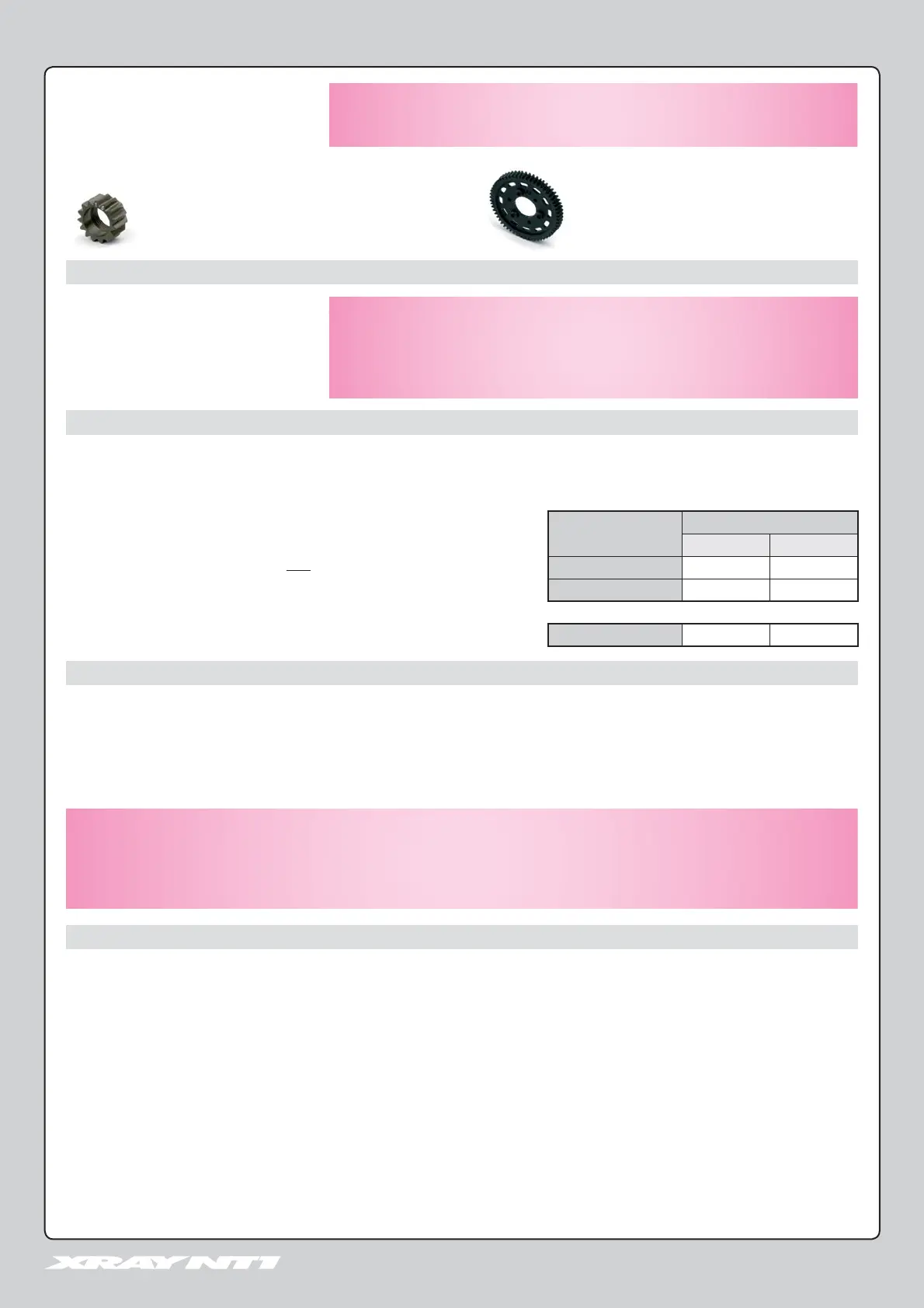37
Pinion Gears
1st gear (smaller, outer pinion) : 15, 16, 17, 18T
2nd gear (larger, inner pinion) : 20, 21, 22, 23T
Spur Gears
1st gear (larger, outer spur) : 57, 58, 59, 60T
2nd gear (smaller, inner spur) : 53, 54, 55T
The “fi nal drive ratio” (FDR) is the ratio
between the DTR and the PDR.
Since FDR is directly affected by DTR, a front
FDR is affected by changes to the mid-side
pulley (which alters the front DTR).
FINAL DRIVE RATIO (FDR)
Rollout is the distance that the car moves forward for one revolution of the engine (or pinion gear). Rollout is not affected by the engine or other
components you are using; it simply defi nes how all of the gears, belts/shafts and tires work together to make the car accelerate and reach top speed.
Rollout is calculated using the circumference of a tire. Since the NT1 uses foam tires, as the foam tires wear and get smaller, the rollout value changes
a lot more quickly.
Rollout calculations may be done for both front and rear wheels, since the FDR ratios for front and rear may be different.
The example below is a calculation of rollout for the rear tires on the NT1 in 1st gear.
Rear Tire Circumference = Rear Tire Diameter x 3.14 (value of Pi)
Rear Rollout = Rear Tire Circumference / Rear FDR (1st gear)
Sample rear tire circumference: 59 mm x 3.14 = 185.35mm
Sample 1st gear rear rollout: 185.35mm / 7.56 = 24.52mm
For each engine revolution in 1st gear, the rear tires move the car forward by 24.52mm
ROLLOUT
GEARING
The 1st and 2nd PDR ratios of the NT1 may
be altered by the use of different combinations
of pinion and spur gears on the clutchbell and
2–speed transmission, respectively.
The “overdrive ratio” (ODR) is the ratio between the front DTR and the rear DTR, and is affected by the mid-side pulley used on the NT1.
Overdrive ratio impacts the difference in rotation speed between the front and rear wheels.
Depending on the mid-side pulley being used, the FDR values will
be different between the front and rear of the NT1:
• Rear DTR of the NT1 is permanently set to 2.05.
• When using the 26T mid-side pulley, both front and rear DTR ratios are 2.05.
This gives a 1:1 overdrive ratio.
The front and rear wheels rotate at the same speed.
• When using the 25T mid-side pulley, the front internal ratio (DTR) becomes 1.97.
When compared to the rear DTR of 2.05, the overdrive ratio now becomes 1.04:1.
The front wheels rotate 4% faster than the rear wheels.
OVERDRIVE RATIO (ODR)
DTR RATIO
MID-SIDE PULLEY
26 25
Front DTR
2.05 1.97
Rear DTR
2.05 2.05
OVERDRIVE RATIO
1 : 1 1.04 : 1
XRAY offers the following gearing options for the pinion and spur gears on the NT1:
Spur / Pinion = PDR
Sample 1st gear PDR:
59T spur / 16T pinion = 3.688
PDR x DTR = FDR
Sample 1st gear rear FDR (unaffected by pulley changes):
3.688 x 2.05 = 7.56
Sample 1st gear front FDR (using 25T mid-side pulley):
3.688 x 1.97 = 7.26
OVERDRIVE RATIO, ROLLOUT, AND TIRE SIZE
When using the 26T mid-side pulley:
If you use the 26T mid-size pulley, the ODR ratio is 1:1 (based on
gearing ratios alone).
When you start racing the car with rear tires that have a larger diameter
than the front (for example, a 2.0–2.5mm difference), the rear wheels will
push the front wheels and the front wheels brake the car.
However, since rear tire wear is usually higher than front tire wear, after
some running time the front and rear tire diameters will equalize and
then the push will equalize as well.
When using the 25T mid-side pulley:
If you use the 25T mid-size pulley, the ODR ratio is 1.04:1 (based on
gearing ratios alone); the front wheels rotate 4% faster than the rear
wheels.
When you start racing the car with rear tires that have a larger diameter
than the front (for example, a 2.0–2.5mm difference), this tire size
difference will neutralize the ODR and the car will be balanced with no
push between the front & rear wheels.
However, since rear tire wear is usually higher than front tire wear, after
some running time the front and rear tire diameters will equalize; the
front wheels will start to pull, and the rear wheels will brake the car.
Please note that this situation varies depending on the type of track and the differences in wear characteristics of the front versus rear tires. It is
important to always individually consider the best and optimal combination of gearing, and diameters of the front and rear tires.
Overdrive ratio and rollout are affected by the diameters of the front
and rear tires used.

